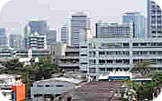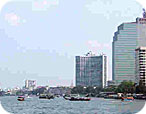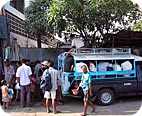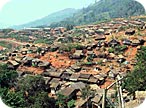| home | our mission | contact us | issue archive |

Jul 2001 / elsewhere :: email this story to a friend

Thai Journal: Bangkok to
Mae Sot
By Dan HellingerLet's start with a basic fact I took from one of the local newspapers. In cities like London and New York, 20-25% of the surface of the city is given over to roads. In Bangkok, the amount is nine percent. Much of the city is a maze of twisting passages and alleyways, some not much more than a couple meters wide, passable only on foot, bicycle, or motorbikes — which are ubiquitous and not uncommonly carrying a family of four (once I saw five!).
After 26 hours of travel from St. Louis, I arrived at midnight in a city full of ghostly, concrete behemoths. This is Bangkok, and I'm just passing through on my way to the southern coastal resort of Hua Hin, close to where Webster University has an overseas campus. I'm there for a ten-week stint to teach some classes. Having visited and written extensively about Latin America, I'm eager to compare my experiences there with what awaits me on my first visit to Asia.
Hua Hin was Thailand's first resort, a sanctuary for the royal family, which still maintains its summer palace in town. Everywhere in Thailand there are billboards and other images of the Thai king, Bhumibol. Many of the scenes seem lifted out of a combination of Norman Rockwell and Mao. There is Bhumibol in the midst of a group, worshipers from different faiths teaching tolerance. Now here he is, plans in hand, directing an irrigation project. The king's now over 70, a fact that cannot be hidden on television. In most of this poster art he is perpetually 30.

There are no posters showing the king directing construction of hotels and office buildings. The half-completed, shadowy skyscrapers never reached maturation because of the economic collapse of 1997. But below them sprawls a labyrinth of narrow streets ("sois") cut between a few broad, traffic-jammed, multi-lane avenues. A few weeks later I made the two-hour journey north from Hua Hin to explore this city, lured by its exotic reputation but armed with knowledge that exoticism exists mostly in the minds of Westerners.
Where are you, Sidney Greenstreet?
In many respects, Bangkok lacks the kinds of high cultural opportunities you might expect from a capital of over 6-million people. Yes, the national palace has spectacular, classic architecture. There's a national museum, but the art is not much different than what you might find in the many wats (Buddhist temples) scattered around the city. The country has over 30,000 of them, by one count. Many are impressive, some distinctive, but I have no more interest in viewing every wat in Bangkok than I have in visiting every church in London. Just as there are many "nails of the true cross" in Europe so there are many relics from the life of Siddhartha. But then again, the Buddha had a few extra lives on Jesus, didn't he?
So what's the attraction of Bangkok? For some it's the two sex districts, Patong and Soi Cowboy. (Soi is best translated as "side street.") You can easily find descriptions of these on the web; I'll just say that the first has a thriving market in more conventional merchandise as well. This provides a good excuse to allow yourself a bit of voyeurism, even if you're not buying the main product.
Soi Cowboy is seedier and, unfortunately, spills over into some of the surrounding district. This means that if you stay at one of the many good hotels in that part of town, even ones quite removed from the notorious soi, you frequently encounter taxi drivers who assume they know what you're looking for. You can hardly avoid it if you are a single male, walking alone in this area. I guess that means men have the opportunity to experience the hassles that women more commonly have to endure. As an older farang, or foreigner, I am a rather attractive customer. Middle-aged farang, as opposed to younger ones, are generally regarded as gentler and more generous. Hence, a gray beard and somewhat less-than-svelte appearance is something of an advantage if you are on the market. It's all business, though, and the touts expect to be turned down. They can even be friendly and helpful once they realize you are not buying what they have to sell.
To give an example from another part of the Bangkok experience, every time I arrive at the bus station, I am greeted by some driver who offers me a "good deal" on a cab ride to my hotel. Usually, he offers to transport me for 350 baht. The price goes down rapidly as I begin to walk away, until finally he gives the "special deal" of 200 baht. Then I tell the tout that I can take any of the plentiful, air-conditioned, metered taxis to my hotel for 100 baht ($2.10). Not only does he desist from offering me a ride, but he calls a meter taxi and helps me with luggage, expecting no tip. Then, he returns to await the arrival of the next bus, and hopefully a less experienced farang.
The best thing you can do in Bangkok is to let a neighborhood swallow you up. Just get lost. Sooner or later, you'll emerge on a major avenue, and you can get some place you know by taxi for less than a dollar. Meanwhile, you can meander down sois and alleys, in and out of shops and chop houses, soaking up the atmosphere. I stumbled across a thoroughly garish but intriguing temple in Chinatown, one of the best places to do this. No one spoke English, but they made it clear I was welcome. I watched an old man tune an instrument that looked rather like a hammer dulcimer and made my own small offering in the donation box (Catholics and Buddhists indeed have some common beliefs).
Exiting, I moved on, deeper into the maze, glancing around corners, half-expecting Sidney Greenstreet to emerge from behind the curtain of the parlor of a wholesale textile shop or dry goods emporium. All around you are the smells of spices and herbs, carried along the pathway by clouds of steam or wafting streams of smoke from barbecue grilles. Along the streets of Bangkok are all kinds of vendors, most selling food. You've got to wonder how anyone makes real living here because everyone is trying to sell something on a cart to someone else, it seems.

Hopping a river taxi on the Chao Phraya, which curves around the old quarters and most ancient palaces, is best way to escape the heat when it is oppressive — and it can reach well over 100 degrees in the afternoon. Several different kinds of boats will take you up and down the river, past the palaces and wats that take on, from that perspective, the appearance of a confectioner's midsummer night's dream. Other parts of the river are lined by old warehouses and rickety floating homes. You might think you've been transported back to the era of colonial steamships encountering junks.
A good stop on the river is Thammasat University. Founded in 1932 by a Thai nationalist, democrat, and socialist, affectionately known as "Pridi," Thammasat is where Westerners and Thais resisting the Japanese were hidden during World War II, where students died in democracy demonstrations (killed by U.S. trained and armed soldiers, it's worth adding) in 1976, and where the organizing that helped bring down a military government in 1992 was centered. This history is commemorated in various monuments and statues around the compact campus, bounded one side by the riverfront, which nowhere looks better, and otherwise by a popular market and park. The park has been a gathering place for all kinds of cultural and political events. The campus authorities now want to move undergraduate programs to the suburbs, and the present struggle is to keep them where they are now, close to the people.
In many ways this society is much less exotic than depicted in the west, but there certainly are barriers to understanding for those, like me, who have zero knowledge of Thai. For example, I noticed a very busy hive of activity in a glass-enclosed room that looked like the anteroom of a doctor's office. I thought it was an insurance business of some type. My Thai companion explained that the "customers" were young couples, many from the university, consulting the authorities on the best time to move into their recently purchased homes. Other kinds of consultation about the best timing for actions were underway as well. (Maybe my guess about insurance wasn't all wrong.).
There are other things to like about Bangkok, such as great restaurants, good music venues, and availability of many movies. It alternately evokes consternation and wonder. It sprawls, congests, heats up ferociously, but entices with scents, sounds, and surprises if you enter its innards. I won't leave my heart there, but I won't forget it either.
The Peripheral Tourist
One weekend I got the opportunity to travel further north. After an eight-hour bus journey from Bangkok, we arrived in Mae Sot. "We" are Brad, a professor from Webster; Tom, his visiting friend; and Roy, a Philippine teacher who works in a nearby refugee camp. Mae Sot is a thriving frontier town in a country where otherwise the economy is in deep trouble. We are near the border with Burma, and the place is teeming with Burmese, Thais, and people from the various hill tribes from both sides of the border.
Actually, "border" is a misnomer. In the late 1800s, British and French colonialists and Thai kings rushed to draw territorial borders around a variety of ethnic peoples and regions which had never pledged exclusive allegiance to any imperial authority. The border today is a river with a suspension bridge for a two-lane highway, plus walkways. There's a lot of legal traffic back and forth, but even more illegal. Just below the guard post, in full view of the soldiers on the bridge, people are wading the river, water up to their necks, contraband on their heads. No one seems to bother them.

"Tribes" is an even bigger misnomer. Taken the Karen, for example. We hopped a samleung (pickup truck with benches, packed with 18 people) for the 2.5-hour trip down the road south to visit the camp where Roy teaches in a program funded by the Soros Foundation. Along the way kids armed with buckets of water twice ambushed our samleung. It's Somkram, Thai New Year, and that's what they do — throw water at one another. Farang are special targets, especially up here, where we are scarce.
The "camp" turned out to be a small city of 15,000 people sprawling over a mountainside. People were all different colors and creeds, and within the ranks of the Karen themselves are two major and a number of smaller ethnic groups. They are Buddhist, Christian and Muslim, and all three religions are well represented by their temples, mosques, and churches in the camp.

From what I've seen of refugee camps, this one is more developed than most. It was moved here, about five miles from the border, because the Burmese military regularly shelled it. There are a few generators and a reservoir for clean water. There are squat toilets that flush in most houses. Still, there's open sewerage running through some parts of it. It's quite an experience to spend an evening there, but I think the most important thing was that it dispelled my stereotype that the hill people in this region are somehow more tribal, or primitive than the majority people.
Back in Mae Sot I got my first Thai massage. Now, having read about Soi Cowboy, your imagination must be running ahead of my story. The masseuse was a blind man, monk-like in appearance, but not a monk. I had a two-hour massage from this expert. Great experience, but it won't get you to nirvana.
The town market is ethnically and gastronomically diverse. Let's see, shall I have that woman reach in the bucket full of live eels, chop and clean it, and have that other person make a nice stir fry, or would I rather have deep fried crickets. Maybe I'll just settle for that exotic looking jack-fruit. The market swarms with Burmese women with their cheeks painted a chalky white to protect them from the sun, Muslim men looking more like Pakistanis than East Asians, Thais, and four different groups of hill people. Gems and teak are the big products. The furniture is unbelievably beautiful and cheap. Golden-grained, teak dining room tables and hutches go for $150 to $200. Another good buy, and more politically correct, is textiles. You buy the hand-woven cloth here and have it made, if you wish, into garments elsewhere. You can get beautiful, custom-made shirts or blouses for less than $20 in this way.
The trade in gems and wood is helping fuel the three-sided war pitting the Burmese, the Thai, and the hill people against one another. The Thais don't particularly like the Burmese, but they too harass the hill people, taking bribes to let them pass over the bridge or leave the refuges camps to work and trade in the market. Back in the south, the Americans are arming and training several thousand Karen to fight the Burmese "rogue state." It's hard to muster much sympathy for the military regime in Burma, but whatever government succeeds this one will have these separatist fighters on their hands.
This reminds me that however unusual the food, religious statuary and painted cheeks may seem to me, the politics here are not so exotic. The dark, hulking towers of Bangkok, peddlers of human flesh in Soi Cowboy, and ethnic resistors of Thai, American, and Burmese imperialism are all enmeshed in a globalization process that doesn't look all that much different from what I've observed in South America.
Dan Hellinger is Professor of Political Science at Webster University.
Church and State | Games | Expatriates | Communities | From the Source
It's All Happening | Young Minds | The Ordinary Eye | Elsewhere
Sights and Sounds | Media Shoegaze | A Day's Work | From the Editor© 2001 The Commonspace
